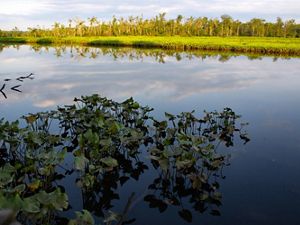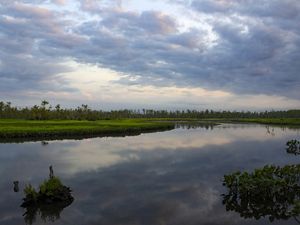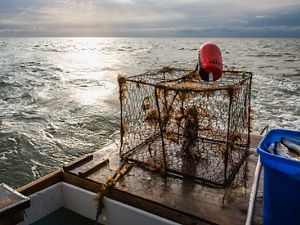Coming Soon: Restored Wetlands Along Ball Creek in Northumberland County
This restoration project fills a missing link in a 1,068-acre corridor of protected land in the United States’ largest estuary, the Chesapeake Bay.
Media Contacts
-
Kelley Galownia
The Nature Conservancy
Phone: (571) 403-4625
Email: kelley.galownia@tnc.org -
Lisa Biever
Northern Neck Land Conservancy
Phone: (540) 907-5371
Email: lisa@nnconserve.org
The Nature Conservancy and Northern Neck Land Conservancy will soon begin construction to restore nearly 10 acres of forested wetlands along Ball Creek in Northumberland County. This project serves as an important milestone in a decades-long effort to restore and permanently protect 223 acres of ecologically-significant land in Virginia’s Northern Neck—a missing link in a 1,068-acre corridor of protected land in the United States’ largest estuary, the Chesapeake Bay.
The site, known as Bay View, is situated between two Virginia Department of Conservation and Recreation Natural Area Preserves—Dameron Marsh and Hughlett Point—and provides an important corridor of connectivity for various migratory birds, as well as nursery and spawning habitat for fish, shellfish, waterfowl and raptors, such as osprey and bald eagles. The site also protects an area that has been designated as significant habitat for the federally-listed threatened Northeastern beach tiger beetle.
"The Bay View site is a special place where people from around the region can experience the power of conservation,” said Lisa Biever, Executive Director of the Northern Neck Land Conservancy. “We are exploring opportunities to install a walking trail around the restored wetland site with views out to the Chesapeake Bay and hope that will be possible in the near future. Conservation is a community value, and we invite everyone to join in the important conversation about protecting land for future generations.”
Construction on the Bay View site is expected to begin in early to mid-August 2023 and will last for approximately two to three months. Once construction is complete, TNC will plant 40 different species of native plants that support wildlife and thrive in forested wetland environments, including sweetbay magnolia, cherry bark oak and swamp milkweed. TNC will continue to monitor and manage the site for 10 years to ensure long-term ecological success.
“This project has provided a unique and special opportunity for The Nature Conservancy, a global environmental organization, to partner with a highly-respected and effective local land trust to restore former fields into wetlands and preserve beautiful stands of mature coastal forest,” said Kati Booth, Wetland Restoration Specialist of The Nature Conservancy. “The protection and restoration of this site will support Chesapeake Bay wildlife, create habitat corridors, build shoreline resiliency in the face of sea-level rise and support the community through planned recreational access to trails and waterways. It is a win-win project all around.”
With approximately 3,500 feet—or nearly 10 football fields—of Chesapeake Bay frontage, the Bay View site and its conversion back to a forested wetland will improve water quality, expand needed wetland habitat and strengthen the resilience of nearby communities. Forested wetland habitat is defined as a forest where soils are saturated or flooded for a portion of the growing season, and vegetation, dominated by trees, is adapted to tolerate flooded conditions.
Quote: Kati Booth

The protection and restoration of this site will support Chesapeake Bay wildlife, create habitat corridors, build shoreline resiliency and support the community through planned recreational access.
In addition, TNC and Northern Neck Land Conservancy are eager to explore recreational access opportunities—such as walking trails and a kayak launch—once construction and restoration are complete.
“This project is a win-win on so many levels,” shared Camille Grabb, Past President of the Northern Neck Chapter of Virginia Master Naturalists and a nearby neighbor of the property. “The forest teems with wildlife, from coyotes and bobcats to deer, raccoons, rabbits, opossums and many species of songbirds and raptors. Butterflies, bees and other insects are prevalent due to the wide variety of native trees, shrubs and wildflowers there. Vernal pools provide breeding habitat for frogs, toads and salamanders. It is commendable that the Northern Neck Land Conservancy and The Nature Conservancy have partnered to preserve and protect the property while allowing the community to access its natural beauty.”
The Northern Neck Land Conservancy’s purchase of the Bay View site was completed in April 2020 in partnership with TNC and was funded through the Virginia Aquatic Resources Trust Fund (VARTF). TNC has maintained its conservation easement on the Bay View property, in addition to a second easement held on 325 privately-owned acres directly south of Ball Creek.
To learn more about The Nature Conservancy’s wetland restoration work in Virginia, visit nature.org/VARTF. To participate in the Northern Neck Land Conservancy’s Fourth Fridays at Bay View, a free monthly open house gathering for visitors, visit nnconserve.org/home/visit-bayview.
The Nature Conservancy is a global conservation organization dedicated to conserving the lands and waters on which all life depends. Guided by science, we create innovative, on-the-ground solutions to our world’s toughest challenges so that nature and people can thrive together. We are tackling climate change, conserving lands, waters and oceans at an unprecedented scale, providing food and water sustainably and helping make cities more sustainable. The Nature Conservancy is working to make a lasting difference around the world in 81 countries and territories (40 by direct conservation impact and 41 through partners) through a collaborative approach that engages local communities, governments, the private sector, and other partners. To learn more, visit nature.org or follow @nature_press on X.







